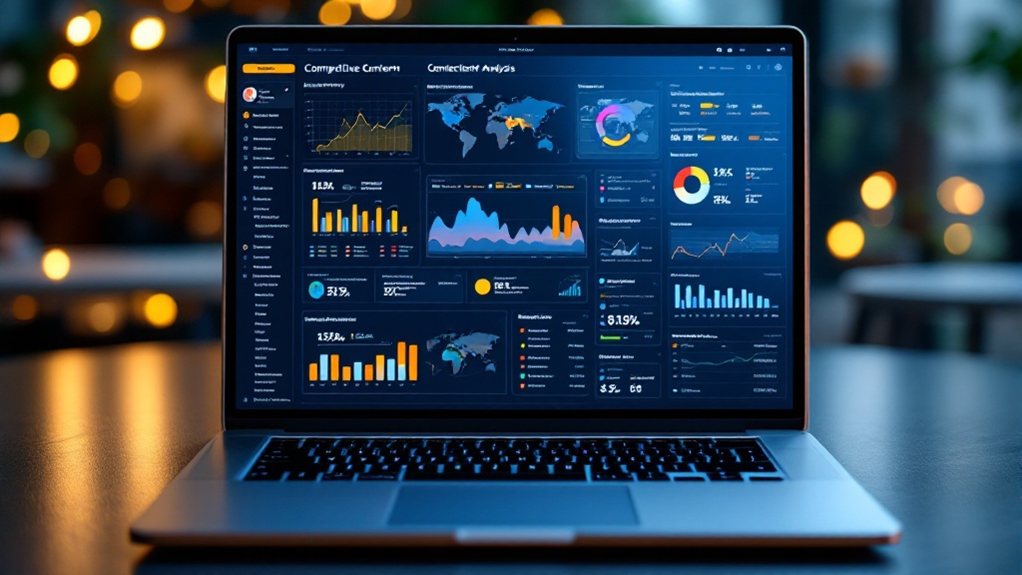Competitor content analysis is key for effective geo-targeting. First, identify your direct, indirect, and influential competitors. Audit their content strategies, evaluate their SEO and engagement metrics, and leverage your unique selling points to differentiate your content. Integrate these insights into your geo-targeting approach – craft targeted content for specific locations, optimize local SEO, and implement geo-conquesting strategies. This will help you outmaneuver your competitors and connect with your local audience. Continue reading to learn more about using competitor content analysis to refine your geo-targeting.
Understanding the Purpose of Competitor Content Analysis

Conducting competitor content analysis is crucial for improving your SEO strategies, identifying content gaps, and enhancing audience engagement. By understanding what your competitors are doing, you can refine your content strategy and promote your brand's unique voice in a crowded market. This analysis provides valuable insights, enabling you to capitalize on your competitors' weaknesses and strengths, optimize your content for better search engine rankings, and make informed decisions based on data-driven insights. Analyzing the strategies behind competitors' content creation aims to identify the strengths and weaknesses of one's own content strategy. Ultimately, competitor content analysis can give you a competitive advantage, boost your website traffic and customer engagement, and help you better target local audiences through geo-targeted content strategies.
Identifying Direct, Indirect, and Influential Competitors

Knowing your competitors is key to crafting effective geo-targeting strategies. Direct competitors offer similar products and services, while indirect competitors may solve the same problems differently. Influential competitors, though not direct rivals, can still impact your target market through their brand reputation and content. Analyzing the marketing strategies of both direct and indirect competitors can uncover opportunities to differentiate your offering.
Defining Direct Competitors
Pinpointing your direct competitors is crucial in crafting an effective geo-targeting strategy. Look for businesses with similar objectives, targeting the same market, offering comparable products or services, and positioning themselves in the same niche. These direct competitors will likely employ strategies to outperform each other, vying for the same customers. Assess their brand recognition, price sensitivity, and how interchangeable their offerings are from the consumer's perspective. Analyzing these characteristics can reveal valuable insights to help you gain a competitive edge in specific geographic locations. Understanding direct vs. indirect competitors is key to this process, as they will require different strategies.
Recognizing Indirect Competitors
While identifying your direct competitors is crucial, you shouldn't overlook the impact of indirect competitors. These businesses serve the same customer needs but offer different products or services. Indirect competitors can significantly influence market trends, as seen with the rise of smartphones challenging desktop computers. Understanding indirect competition is key to identifying market gaps and developing effective strategies.
| Differentiating Direct vs. Indirect Competitors | |
|---|---|
| Direct Competitors | Indirect Competitors |
| Similar products and target markets | Different products, same customer needs |
| Consistent pricing | Varied pricing |
| Direct marketing to similar segments | Focus on product differentiation |
Analyzing the content and geo-targeting strategies of indirect competitors can provide valuable insights to inform your own marketing efforts.
Identifying Industry Influencers
Identifying industry influencers – whether they're direct, indirect, or highly influential competitors – is crucial for gaining a comprehensive understanding of your market landscape. Look for companies that set industry standards, have strong brand recognition, and consistently innovate. Analyze their content strategies, partnerships, and social media presence to gauge their influence. Understand how they affect market dynamics and consumer behavior. Evaluate their content engagement, customer loyalty, and thought leadership to recognize their impact. Use these insights to refine your unique value proposition, develop innovative content, and deploy targeted marketing strategies that resonate with your audience.
Conducting a Comprehensive Content Strategy Audit

As you review your content inventory, take a closer look at the different content types and how they're performing. Analyze the SEO effectiveness of your content to identify areas for improvement. By understanding what's working and what's not, you can optimize your content strategy and better target your audience.
Evaluating Content Types
Evaluating content types is a crucial first step in conducting a comprehensive content strategy audit. Begin by classifying your content into categories like blog posts, social media updates, videos, and articles. Assess the relevance of each piece to your current business goals and audience interests. Analyze the structure and organization of your content, and check for consistency across different platforms and channels. This will help you identify any gaps or inconsistencies in your content offerings. Use performance metrics like page views, shares, and comments to gauge the engagement levels of your content. By understanding which content types resonate most with your audience, you can make informed decisions about your content strategy. [Categorizing content by type can reveal opportunities for repurposing and cross-promotion across channels.
Assessing SEO Effectiveness
Effectively assessing your SEO performance is crucial when conducting a comprehensive content strategy audit. Use tools like SEMrush or Ahrefs to monitor your keyword rankings over time, tracking improvements, declines, and fluctuations. Focus on long-tail keywords for better targeting and analyze search intent to adjust your strategies. Track your organic traffic trends in Google Analytics, comparing them to other channels. Ensure your title tags, meta descriptions, and content structure are optimized. Conduct competitor analyses to identify their strengths and weaknesses, then reverse-engineer their successful strategies. Analyzing the website's backlink profile is essential to understand its off-page SEO efforts. Leverage data-driven approaches, utilizing Google Search Console and Analytics, to inform and continuously refine your SEO efforts.
Evaluating Competitors' SEO and Engagement Metrics
Understanding your competitors' SEO and engagement metrics is crucial for gaining a competitive edge in the market. Analyze their keyword strategies, backlink quality, and content approaches to identify opportunities. Evaluate their technical SEO strengths, such as site speed and mobile usability. Monitor their ranking positions over time to assess their SEO effectiveness. Examine their social media engagement, bounce rates, and time on site to gauge user interaction. Use heatmaps to track visitor behavior and analyze their content formats, depth, and promotion strategies. Analyzing their geo-targeting tactics can provide valuable insights to refine your own approach. This comprehensive analysis will equip you with the insights needed to outperform your rivals.
Leveraging Unique Selling Points for Content Differentiation
Once you've gained a comprehensive understanding of your competitors' SEO and engagement strategies, it's time to shift your focus towards leveraging your own unique selling points (USPs) to differentiate your content and outshine the competition. By clearly identifying and effectively communicating your USPs, you can create content that resonates with your target audience and sets your brand apart. Utilize storytelling techniques to illustrate the unique benefits of your product or service, and optimize your content for SEO to ensure your USPs are prominently featured in search results. Consistently integrate your USPs across all marketing channels to reinforce your brand's differentiating factors and drive customer conversions.
Fundamentals of Geo-Targeting for Improved Relevance
Delivering location-driven content can boost your relevance to users. Personalized user experiences tailored to their geographic context foster stronger engagement. Measure the effectiveness of your geo-targeting efforts using key metrics to refine your strategy.
Location-Driven Content Delivery
Location-driven content delivery is a powerful way to enhance the relevance of your marketing efforts. By leveraging real-time data on user locations, you can tailor your messages to specific geographic areas, improving engagement and conversion rates. Consider these key advantages:
- Personalized Experiences: Deliver content that resonates with your audience based on their location, enhancing their overall experience with your brand.
- Targeted Campaigns: Exclude irrelevant locations and focus your efforts on high-potential areas, optimizing your marketing spend.
- Competitive Advantage: Stay ahead of the curve by utilizing location-based strategies that your competitors may not be employing effectively.
Personalized User Experiences
When leveraging geo-targeting, you can create personalized user experiences that resonate with your audience and boost engagement. By tailoring content to regional preferences, matching currencies and languages, and delivering timely, location-based recommendations, you can enhance user convenience and satisfaction. Real-time geolocation features can further improve the user experience, while security measures leveraging geolocation data can increase trust. However, it's crucial to balance personalization with privacy concerns, ensuring transparency and obtaining user consent. By collecting feedback and continuously refining your strategies, you can deliver highly relevant, location-driven experiences that drive increased conversion rates.
Geo-Targeting Measurement Metrics
To effectively measure the success of your geo-targeting efforts, you'll want to track key performance indicators (KPIs) that align with your campaign goals. These include:
- Click-through Rate (CTR): Measure the proportion of users who click on your ads after viewing them.
- Conversion Rate: Track the percentage of users completing a desired action, like making a purchase or filling out a form.
- Revenue Generated: Monitor the income produced from your geo-targeted campaigns.
Consistently reviewing these KPIs and optimizing your campaigns accordingly will help you maximize the impact of your geo-targeting strategy.
Integrating Competitor Analysis With Geo-Targeting Strategies
Integrating competitor analysis with your geo-targeting strategies can provide invaluable insights to enhance your marketing efforts. By conducting local competitor analysis, you'll gain a deeper understanding of regional market dynamics. Leveraging geolocation technology, you can monitor competitors' locations and customer behavior to create detailed profiles. This allows you to tailor your geo-targeting strategies effectively, including geo-conquesting – targeting customers near competitors' locations. Utilize market assessment tools to evaluate conditions and competitor performance in specific areas. Combining these insights with hyper-local targeting, behavioral insights, and cultural sensitivity will maximize the impact of your geo-targeting campaigns. Continuous monitoring and technological integration are key to staying ahead of the competition.
Crafting Targeted Content for Specific Geographical Locations
Crafting targeted content for specific geographical locations requires an understanding of your local market and the unique needs of your audience. This may involve:
- Adapting your language and cultural references to resonate with your local audience.
- Incorporating local-specific products or services to increase relevance.
- Ensuring your content aligns with local regulations and policies.
Optimizing Local SEO With Competitor Insights
Analyzing your local competitors' strategies can provide valuable insights to optimize your own local SEO efforts. Identify your top competitors by examining local search results and directories. Audit their Google Business Profiles, online reviews, and media content to understand their approach. Leverage competitor analysis tools to track their keyword rankings and strategies. Implement effective local SEO tactics, such as consistent NAP, local directory listings, and high-quality content tailored to your target audience. Stay up-to-date with local SEO trends and regularly review your competitor's performance to identify new opportunities. By leveraging competitor insights, you can enhance your local visibility and outperform your rivals.
Implementing Geo-Conquesting Strategies Using Competitor Analysis
When implementing geo-conquesting strategies, you'll want to leverage competitor analysis to gain a strategic advantage. This includes:
- Identifying competitor weaknesses in their geo-targeting approaches to exploit opportunities.
- Utilizing audience insights from competitors to refine your own targeted messaging.
- Highlighting your unique selling points over rivals to attract their customers more effectively.
Continuously assessing and refining your geo-targeting strategies is key, as is ensuring consistency across platforms. By overcoming challenges like location services requirements and privacy concerns, you can effectively measure the success of your geo-conquesting efforts through metrics like foot traffic, sales, and ROI.
